The Ultimate Guide to Writing in Enterprise Sales — How to Craft Internal Narratives


I’ve concluded writing is the most highly-important, under-developed skill for sales reps.
If you study standout reps landing six, then seven, then eight-figure deals, you’ll see a pattern. They all learn how to write compelling narratives.
They can distill hours of conversation into a page of content. Without seeming to have left anything out. They can package their message so it spreads up, down, all around an account.
Yet, only a handful of sales teams train their reps on how to write.
Instead, reps are given template emails, about-us decks, and content filled with marketing speak. Which serve as fine starting points or supplements.
But enablement content isn’t a crutch that excuses sellers from writing.
The reason is buying decisions aren’t made in sales meetings — the moments that decide deals happen in a buyer’s internal meetings. When sales reps aren’t in the room.
Writing is how you bridge that gap, to control your message and enable your champion.
Therefore, writing isn’t a “marketing” skill. It’s one every enterprise rep must master.

Internal narratives create and close deals.
When I talk about writing in the context of complex sales, I’m not talking about emails or product decks. I’m referring to the art of crafting narratives.
Because nothing happens in the enterprise without a strong narrative backing it.
Conflicting opinions, corporate politics, change avoidance — among many other obstacles — all block enterprise projects. Narratives are how you break through them.
In short, narratives package ideas in a way others can understand, share and act on them. Narratives bring meaning to goals, influence to decisions, and alignment to teams.
Corporate narratives are:
- All around you.
- As short as a sound bite, or as long as a six-page report.
- Sticky and contagious. Everyone shares them, and they never forget them.
- You can find them in the phrases that get repeated during every all-hands. Spot them by how executive updates are framed.
Narratives become internal, not external, when a buyer takes and shares it as their own.
This is key, because narratives never live alone. Projects only gain momentum when they’re connected to other stories inside a company. So think of narratives like constellations — a wide system of related stories moving together.
Enterprise employees know their requests are either approved, or denied, based on how well they can tie their narrative into other, already-accepted narratives. For example:
“We plant the seeds for an upsell, or churn in the first 30 days.”
- A VP of Success looking to resource their new accounts team, so they build a narrative that ties into the CRO’s focus on net revenue retention (NRR).
“Enterprise customers are the path to double-digit growth.”
- A CRO who needs marketing, sales, and success to support a move upmarket, so she ties her narrative into the CEO’s focus on showing double-digit monthly growth.
Think about it for a second. What are the narratives floating around your company? Who created them? Who’s sharing them around, and why?
Focus on written content, not just conversations.
Narratives are both written and spoken. Often, they travel in both forms.
That’s why enterprise reps are ambidextrous. Like an actor who both writes and delivers their own script, tops reps communicate as well in written content as they do in conversation.
There are, however, several advantages to writing the narrative you’re building with buyers:
- Deliver the perfect message in a controlled environment.
Writing lets you lay out your message under the ideal conditions. Zero stage fright, no interruptions, and an audience’s undivided attention. You’re judged by your content, not your charisma.
- Writing prunes the excess.
It’s easier to spot the details that are distracting, and disposable, when you write. Points that aren’t absolutely critical to your case get cut.
- Quickly bring new buyers up to speed.
Operating from a living document allows your message to evolve as more buyers enter the sales process. Plus, it eliminates the “telephone effect,” giving context to the contacts who weren’t part of past conversations.
- Optimize for understanding.
If you want a decision maker to understand your message the first time, have them read it. Reading requires focus. It’s easier to zone in and out of a rep presenting a deck or demo.
- Influence when you’re not in the room.
I mention this above, but it’s worth repeating. Buyers have meetings about you, without you. Champions won’t read from your product deck in those meetings. But they will share from a well-packaged memo you wrote with them.
Good writing is clear thinking made visible.
That’s a quote from Ambrose Bierce. He wrote it over 100 years ago. Nothing’s changed.
If you learn to think like an executive, you’ll write in a way that appeals to an executive. The shortcut to thinking like an executive is developing a set of mental models that can organize your point of view, before you write.
1. The Minto Pyramid
This model is named after its creator, Barbara Minto, during her time working at McKinsey. She describes it as, “A tool for logic in writing, to help you find out what you think.”
The Pyramid helps you to settle on a set of ideas that are mutually exclusive from each other, and collectively exhaustive in supporting one main point.
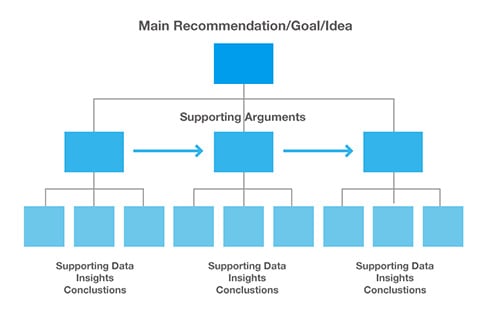
Here’s what the Pyramid looks like, and how to build it:
- Start with a short, specific answer. Executives want the headline first.
- Summarize three arguments supporting your big idea.
- Logically order sub-points backing up those arguments.
A similar acronym to remember is BLUF: bottom line up front.
Here’s an example of putting the bottom line up front (just don’t copy all this corporate jargon...).
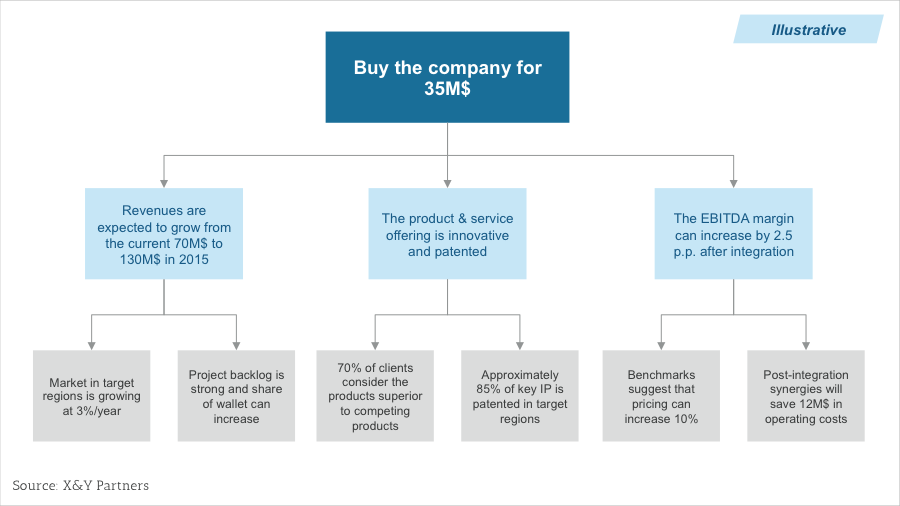
2. Zoom Out, Zoom In
The Zoom Out, Zoom In model shifts a traditional one- or three-year narrative to 10+ years (zoom out), and 6 months (zoom in). This makes it particularly effective for players reshaping industries, and it’s been used to guide the narratives of major tech firms and Silicon Valley legends.
To use the framework, answer two main questions:
- Zoom Out: What will your prospect’s market or industry look like in 10 years? In light of that, what kind of company do they need to become to be survive?
- Zoom In: What project should be implemented inside the next 6 months to start shifting toward that future? And how will progress be measured?
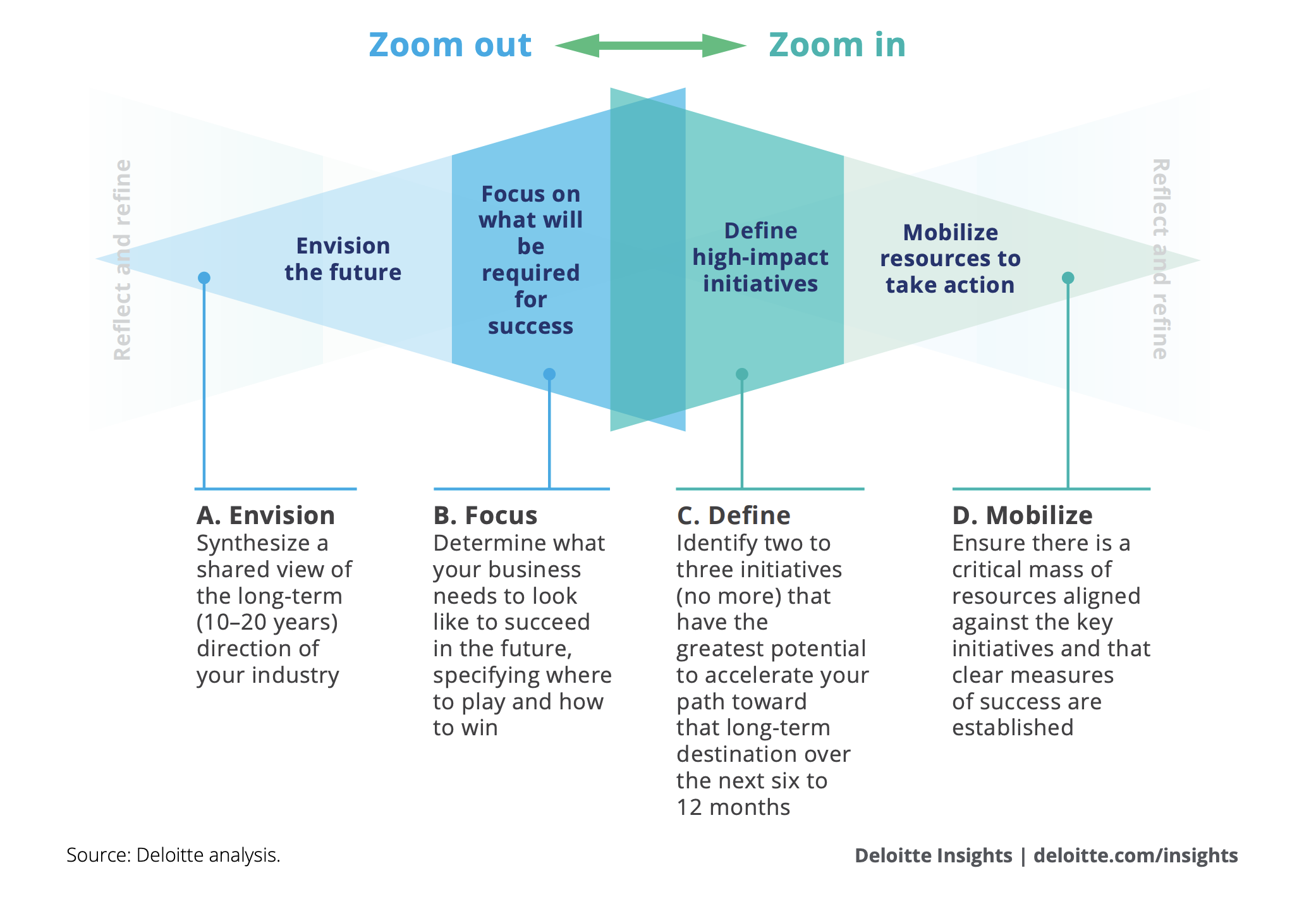
3. Driver Trees
Creating a clear plan for your buyer requires a deep understanding of how their business works. What's their problem’s root cause, and what drives the outcomes they’re after?
Driver Trees model the cause-and-effect relationships behind a company’s metrics.
By linking “outcomes” to a series of “input” metrics, Driver Trees simplify complex goals into their drivers. Just as the name suggests. On the left side of the Tree, you list the target metric you’d like to influence. The right side of the model shows you how.
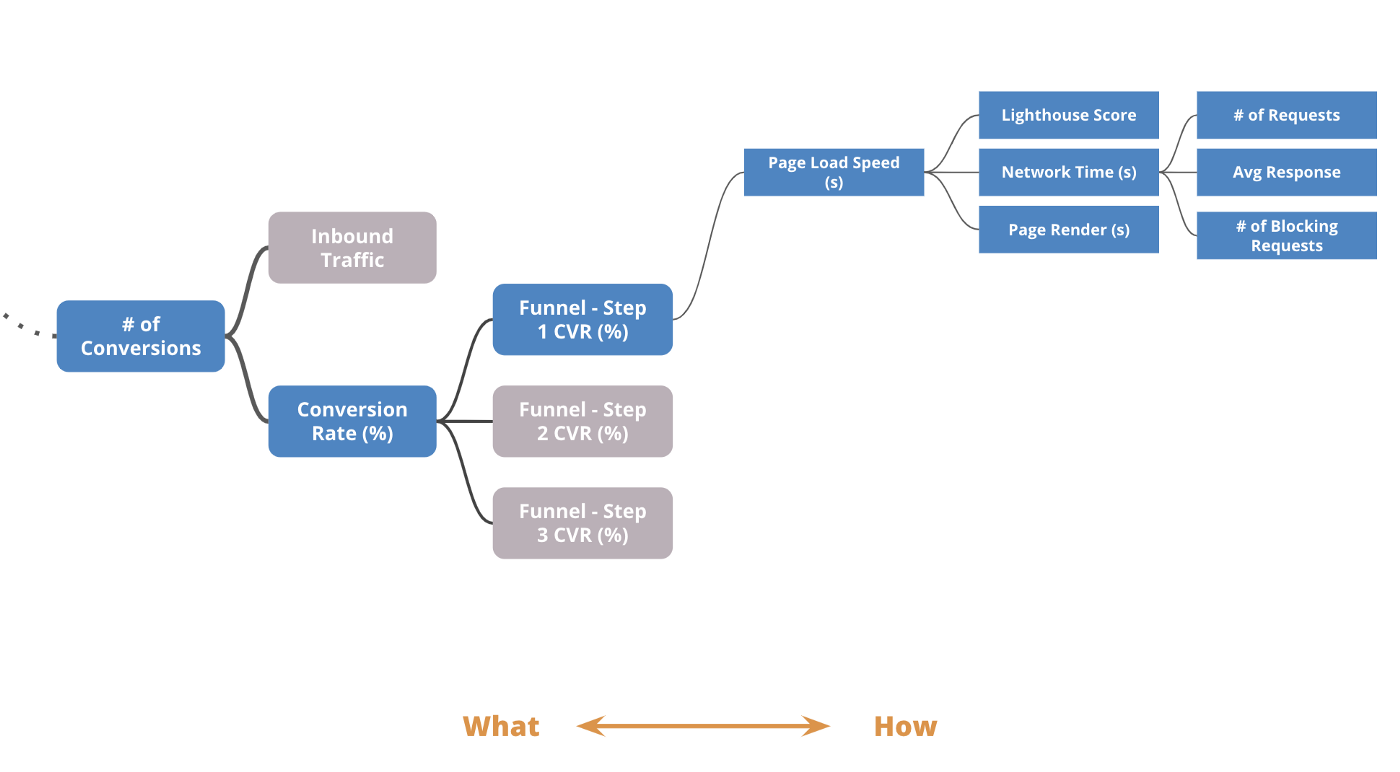
Focus on frameworks, not templates.
Once you’ve clarified your thinking, it’s time to organize the broad strokes of your narrative. This is where frameworks come in. They let you drop new content into a consistent starting point.
A good framework sits somewhere in the middle of a:
- Blank Page. This forces you to be specific for every buyer, but takes too much effort.
- Template. It’s fast and easy, but it sacrifices relevance and effectiveness.
You’ll want to develop a set of frameworks for the different roles, industries, or solutions you sell.
To give you a starting point, here’s The 1-Page Sales Framework. It's built in a Google Doc, so you can download and adapt it for your own pipeline.
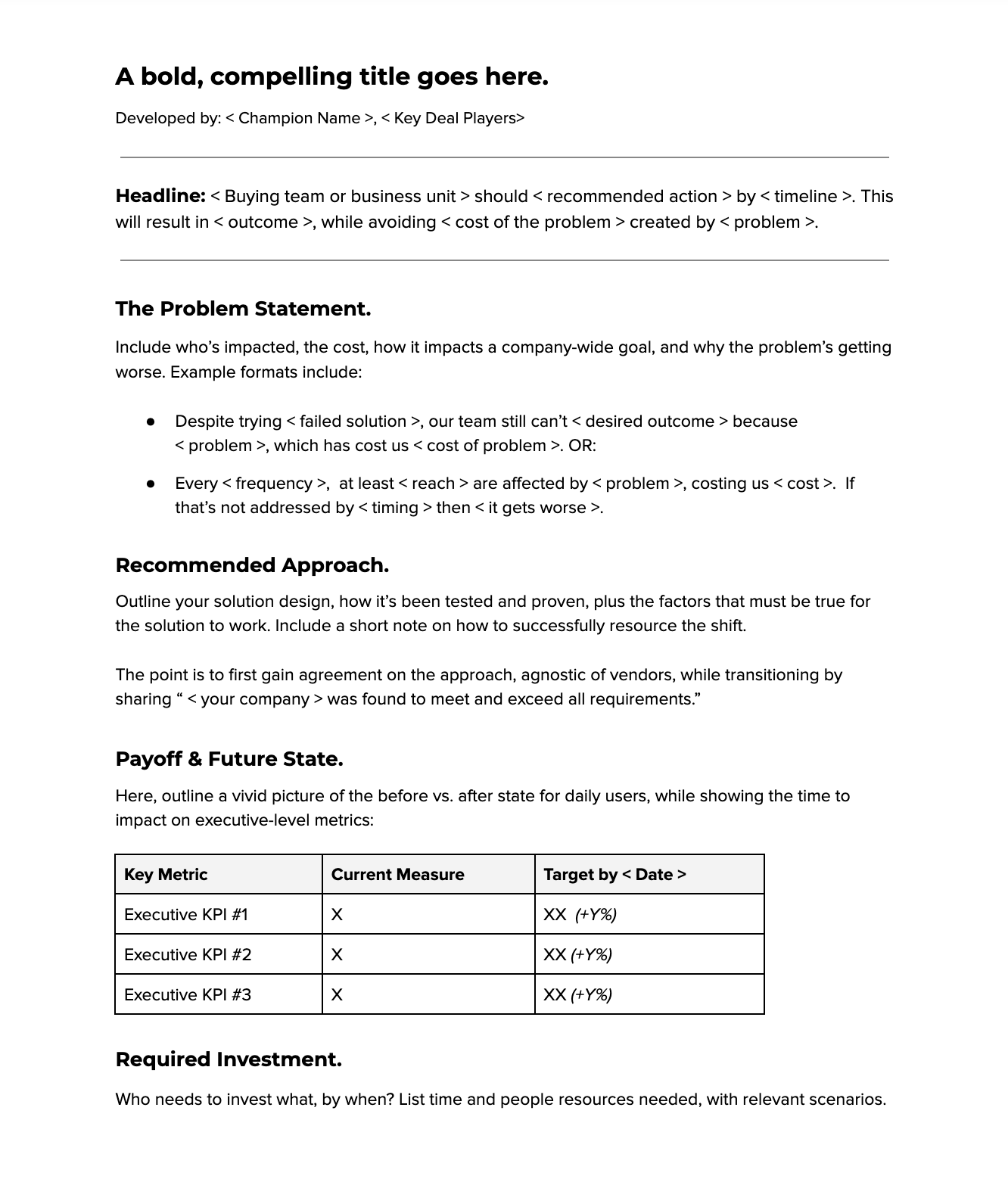
Here are a few more pro-tips to use alongside this framework:
- Don't list your name as the author. The point is to help your buyers craft their narrative.
- Start with a two-sentence headline. Summarize your big idea, and create enough interest to compel your reader to keep reading. This also frames up the rest of your content.
- Keep it collaborative. Use a tool like Notion, a simple Google Doc (or Fluint, of course) to write with your buyers. Involve them, don’t write alone.
How to shape sentences that sell.
With your framework in place, we arrive at the art of what most consider to be “writing.” Choosing words, and shaping sentences. Here’s a shortlist of practices to help you cook up some tasty content.
1. Use Your Buyer’s Own Words
Communication happens in your reader’s mind. Not yours as the writer. If your buyers need to translate your jargon into something more familiar, you’ll lose their attention.
The fast, failsafe approach to creating good content is to let your buyers do the writing. Record and transcribe your conversations, then highlight excerpts of their exact words.
If they use a specific word while describing their problem, use it. Especially if it’s different from what other buyers say, while experiencing the exact same problem.
2. Blend Ethos, Logos, and Pathos
Persuasive writing combines all three elements of rhetoric. They’ve been used for thousands of years to communicate and influence:
- Ethos: credibility and trust. “Trust me, I've closed millions over a decade of experience.”
- Logos: help your audience reach a conclusion before you do. “Successful peers have found a way to do, 1, 2, 3. Therefore, you should…”
- Pathos: create an emotional appeal. “Hundreds of employees could lose their jobs.”
3. Create a masterpiece with visual and musical language.
Visual language uses metaphors, similes, or analogies to conjure up a vivid mental picture:

- “Our sales will ramp up faster than a Formula 1 driver in second place.”
- “Our workflow is like trying to chop down a tree with a butter knife.”
- “Our backlog of support tickets is longer than Apple before an iPhone release.”
Musical language, by contrast, uses tools like alliteration, word count, and punctuation to make the page sing. As if your reader can hear the tone and pace of your voice.
4. Aim for Accuracy, Not Complexity
Use a thesaurus while you write. The goal is to choose words that communicate your point exactly as you’d like to. Not to choose more sophisticated words.
To repeat: use words everyone knows, that more precisely describe your point.
5. Use headlines, bold, and bullets.
Nobody reads your sales materials from first to last word, in order. We work our way down the page several different times, going slightly deeper on each pass by working through:
- Headlines
- Bold and highlights
- Bullets and breakouts
- Full sentences in interesting sections
- The rest of the content for extra context
You’ve probably read this post this way. So use headers, highlights, bold and bullets thoughtfully. Spend as much on this part as you do drafting your content.

Refreshing your sales content, or building a business case for a specific deal?
Send your draft to me. My email is nate@fluint.io. I’ll take a look, and send you three suggestions to shape your narrative, and sell with your words. (Give me a day or two, but I'll get back to you.)
FAQ's on:
Why stop now?
You’re on a roll. Keep reading related write-up’s:
Draft with one click, go from DIY, to done-with-you AI
Get an executive-ready business case in seconds, built with your buyer's words and our AI.
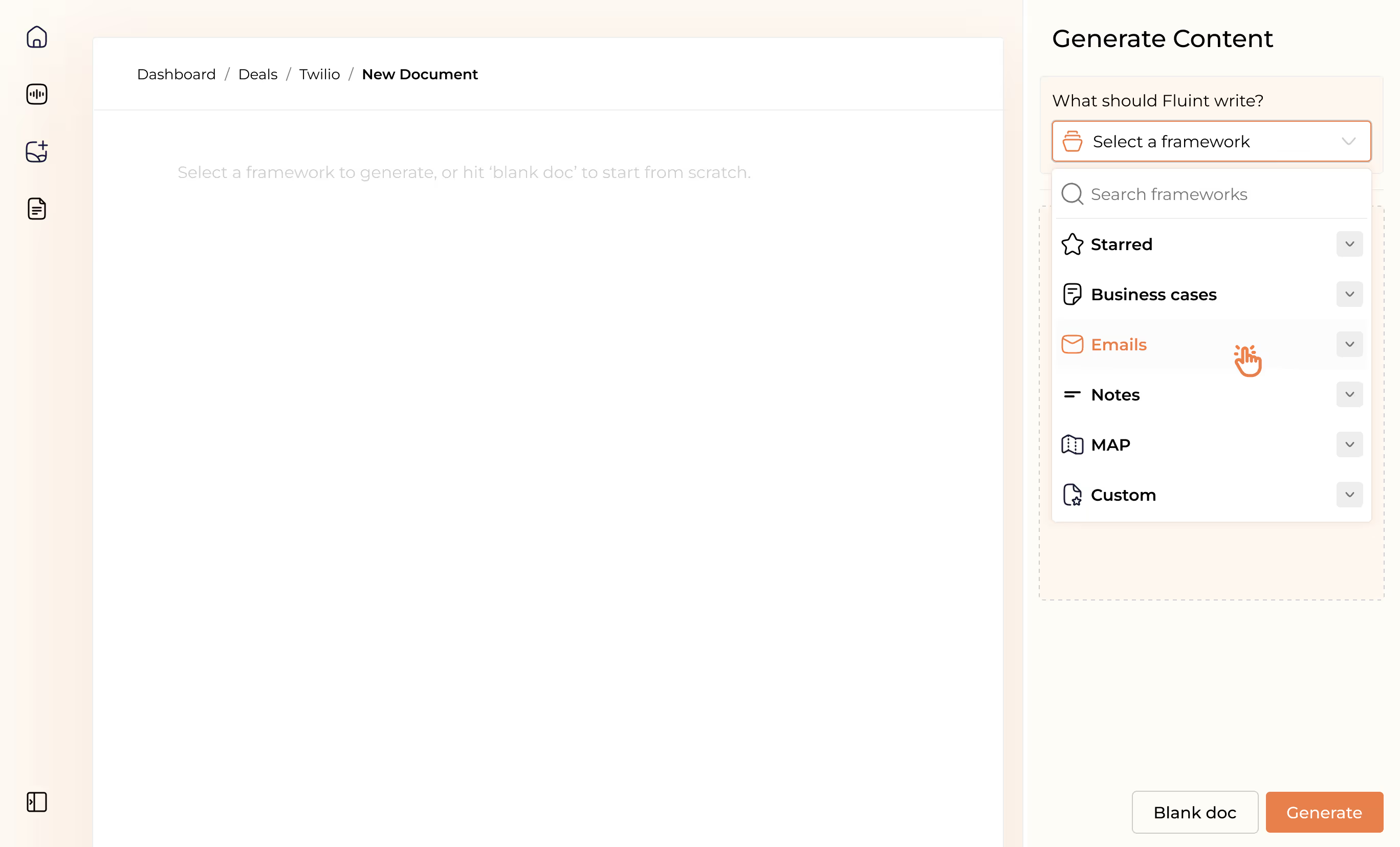
Meet the sellers simplifying complex deals
Loved by top performers from 500+ companies with over $250M in closed-won revenue, across 19,900 deals managed with Fluint

Now getting more call transcripts into the tool so I can do more of that 1-click goodness.



The buying team literally skipped entire steps in the decision process after seeing our champion lay out the value for them.


Which is what Fluint lets me do: enable my champions, by making it easy for them to sell what matters to them and impacts their role.








